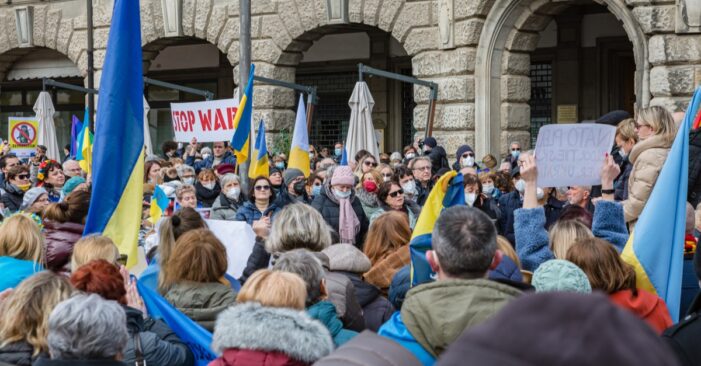Udine, Italy – March 2022: Demonstration support of Ukraine and against the Russian aggression. Protesters, holding banners and Ukrainian flags, against Russia’s war in Ukraine in Udine, Italy. (Shutterstock)
By Eric Levitz, NY Mag
For the first time since Russia launched its invasion of Ukraine three weeks ago, there is hope for peace.
On Thursday, talks between Russian and Ukrainian leaders entered their fourth day. This by itself is auspicious: All previous sit-downs between the two sides had been acrimoniously terminated after a single day of negotiations. And the talks’ longevity reflects apparent progress toward a mutually acceptable settlement.
Ukrainian president Volodymyr Zelenskyy said Tuesday that Ukraine recognized it cannot join NATO, explicitly forfeiting an objective that had been enshrined in Ukraine’s constitution and that Russia had long deemed an affront to its security interests.
For its part, the Kremlin has drastically downsized its official war aims in recent days. When Vladimir Putin first ordered his invasion of Ukraine, the Russian leader called for the overthrow of Zelenskyy’s government, the dissolution of the Ukrainian military, and the installation of a new, Russia-aligned regime in Kyiv. These objectives were premised on the notions that Ukrainian nationalism was a negligible force and that Russia could conquer Kyiv within a matter of days. Ukraine’s strong attachment to self-determination, the west’s willingness to wage economic war on Kyiv’s behalf, and the underperformance of the Russian military quickly rendered Putin’s goals ludicrous.
If Russia were willing to shell Ukraine into rubble and lose tens of thousands of troops, it might be able to topple the Ukrainian government. But defending a reviled puppet regime against a perpetual insurgency, while suffering devastating economic isolation, would be a recipe for national self-sabotage, if not suicide. Putin’s refusal to back down from his initial war aims amid his army’s first setbacks called the Russian president’s rationality into question.
But now, the Kremlin is finally moderating its demands in deference to reality. On Wednesday, Russian officials expressed openness to a peace agreement that would allow an independent Ukraine to maintain its own military as long as it committed to a “neutral status” akin to that of Austria or Sweden. By pledging neutrality, Ukraine would be obligated to refrain from military conflicts beyond the defense of its own territory against an aggressor. This would bar Ukraine from joining NATO or any other military alliance and prohibit it from intervening in, for example, a hypothetical war between Russia and Georgia or any other regional power. Russia is also asking Ukraine to forswear hosting foreign military bases in its territory. In exchange for these concessions, Ukraine would receive “security guarantees” from some combination of friendly powers, possibly including the U.S., the U.K., and Turkey.
Russian foreign minister Sergey Lavrov said of the proposals for an independent but neutral Ukraine on Wednesday, “There are absolutely specific formulations, which in my view are close to agreement.” Lavrov added that, although negotiations have not been easy, there was “some hope of reaching a compromise.”
Zelenskyy, meanwhile, told reporters that Russia’s demands were becoming “more realistic.”
Nevertheless, if the path to a peace settlement is coming into view, the obstacles arrayed across it are still formidable.
Ukraine officially rejected the “Swedish model” of neutrality on Wednesday, with its top negotiator, Mykhailo Podolyak, saying, “Ukraine is now in a direct state of war with Russia. As a result, the model can only be ‘Ukrainian’ and only on legally verified security guarantees.”
At first blush, this may seem like a distinction without difference or like mere posturing for Ukrainian nationalists who would chafe at the idea of fighting and dying for “Swedish” neutrality instead of a properly “Ukrainian model.” But Podolyak’s concern for verifiable security guarantees is rooted in a well-founded skepticism of such assurances. In 1994, Ukraine agreed to forfeit all of the nuclear warheads it had inherited from the Soviet Union, handing over the world’s third-largest atomic arsenal to Russia in exchange for written security assurances from the United States, Russia, and the United Kingdom, each of which swore to respect Ukraine’s territorial sovereignty and to “seek immediate United Nations Security Council action to provide assistance to Ukraine … if Ukraine should become a victim of an act of aggression.” Of course, Russia violated this commitment with its invasion, and the western nations’ promise to seek U.N. authorization for intervention on Ukraine’s behalf proved worthless, given that Russia enjoys veto power over the U.N. Security Council.
Therefore, Ukraine will want a binding promise from some combination of western and neutral powers that they will intervene to defend the nation against any future act of Russian aggression. Whether Putin would be willing to tolerate a peace settlement that leaves Ukraine less vulnerable to Russian coercion than it had been before his invasion is uncertain.
Further, the precise nature of Ukraine’s neutrality appears to be the least contentious issue under discussion. The most intractable dispute concerns Russia’s demand for Ukraine to recognize the Russian annexation of Crimea along with the independence of two newly formed separatist mini-states in the eastern Donbas region.
Ukrainian opinion looks anything but conciliatory on these points. In a poll taken in early March, nearly 80 percent of Ukrainians said they were not “ready to accept” Russian sovereignty over the Donbas, even if doing so “guaranteed an immediate end to the war.”
Ukrainians reject Russia’s demands, poll finds
79% against recognizing “LDNR” as Russian
75% against recognizing occupied Crimea as Russian
56% are against the ban on Ukraine’s membership in NATO even if it ends the war.https://t.co/92FlVxgsK8 pic.twitter.com/V6JvI1S5GV— Euromaidan Press (@EuromaidanPress) March 9, 2022
Since that survey was taken, the Russian shelling of Ukrainian cities and the slaughter of civilians have dramatically increased, even as the Ukrainian military has held up better than expected against attempted Russian advances toward Kyiv. It is possible that these developments would have rendered Ukrainians even less amenable to large concessions.
Yet the two sides might have found a way around the impasse. In an interview with the Financial Times, Podolyak said Ukraine and Russia are currently negotiating over “a guaranteed withdrawal from the territories that have been occupied since the start of the military operation on February 24.” This would facilitate an end to Russia’s broader invasion of Ukraine without requiring either side to formally surrender in the border disputes that have been raging since 2014.
The single biggest question looming over the talks, however, is Moscow’s sincerity. Even as Russian and Ukrainian officials made steady progress at the negotiating table this week, Russian forces have subjected Ukrainian cities to three consecutive days of heavy shelling. Further, although Lavrov and other Russian officials have moderated their demands, Putin himself continues to insist that his military operation is going exactly as planned and that its full aims will be achieved. At the same time, the Russian president’s rhetoric about the war and his treatment of domestic dissent have grown increasingly fascistic. “Russian people will always be able to distinguish true patriots from traitors and just spit them out like a fly that accidentally flew into their mouth,” Putin said on Wednesday. “Such a natural and necessary self-purification of the society will only strengthen our country.”
The city council of Mariupol reported on Wednesday that a Russian plane dropped a bomb on a theater where hundreds of civilians had sought shelter.
In Mariupol, a jet (assumed to be Russian) dropped a bomb/munition on the city’s main drama theater. According to the city council, hundreds were sheltering inside. Casualties currently unclear. Video: https://t.co/1njV23K7PD pic.twitter.com/ooUXq0ZyP2
— Mike Eckel (@Mike_Eckel) March 16, 2022
These developments have led some Ukrainian officials to fear that the Russians’ concessions are merely a stalling tactic, their true aim being to buy time to regroup the Russian forces before resuming an all-out offensive aimed at total victory. And on Thursday, the Kremlin lent credence to such anxieties. In response to reports that “major progress” had been made in peace talks Russian spokesman Dmitry Peskov said that such accounts were “wrong,” and that Ukrainian negotiators were seemingly “in no rush” to reach a reasonable compromise.
If Russia’s plan is to use negotiations to wrong-foot the Ukrainian military, it is not working very well. While Ukraine’s diplomats sketch the outlines of a peace agreement, its president has been securing stronger air defenses through a series of direct addresses to foreign legislatures. On Wednesday, Zelenskyy implored Joe Biden to be a “leader for peace” in an address to the U.S. Congress. Biden subsequently announced an additional $800 million in military assistance to Ukraine as part of the broader $13.6 billion aid package Congress authorized last week.
NEW: Here’s the detailed list of the $800M in military equipment President Biden just announced the US is providing Ukraine. pic.twitter.com/q2C9sG8f0K
— Peter Alexander (@PeterAlexander) March 16, 2022
To the extent that Russia’s concessions are sincere, they are the fruits of military setbacks and economic devastation. Any plausible peace agreement would be a tacit admission of Russian defeat. Putin’s invasion may succeed in ending Ukraine’s bid for membership in NATO and the E.U. And it may secure Kyiv’s formal commitment to neutrality in any future conflict between Russia and the west. But it has already consolidated the anti-Russian turn in Ukraine’s domestic politics, strengthened the European Union and NATO, and weakened Russia economically, diplomatically, and militarily. Any peace that leaves Ukraine’s sovereignty and military even partially intact will represent the utter defeat of Putin’s ambitions for a Russian sphere of influence stretching south from Moscow all the way to the Black Sea.
Such a settlement will be possible only if Putin believes victory is not. Ukraine has evidently shaken Moscow’s faith in the latter possibility. If nothing revives the Kremlin’s hopes in the coming weeks, Putin just might give peace a chance.

